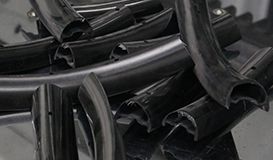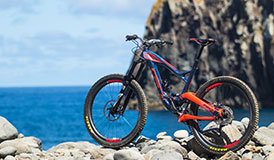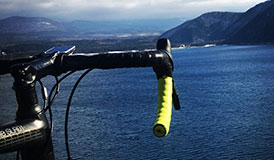What is Lateral Stiffness?
Lateral stiffness in a rim or wheel speaks to the level of movement from side to side. A wider rim doesn’t flex from side to side as much as a narrow rim, so it can be characterized as having more lateral stiffness.
Already know much about lateral stiffness? Skip to the test section.
Riding Characteristics
Laterally stiff rims feel more responsive during powerful accelerations like sprinting; you get a direct power transfer. Steering and handling feel sharper, but this could also have the feeling of harshness under some conditions. On a mountain bike, you would clearly notice the difference between rims with a wide variance in stiffness when rapidly cornering. It usually takes a few rides to adjust to the bike's handling on account of a new wheelset.
What is more desirable?
In general, it comes down to personal preference, coupled with rider weight, discipline, and terrain type. Some road racers might prefer the stiffest wheels they can comfortably ride over a given distance or surface. Gravel racers will need to give up some stiffness if they are hitting a lot of washboard at high speed. Long-distance riders might want a softer and more comfortable ride. Some DH racers prefer less side stiffness so the wheels track the way they prefer through most conditions, whereas an enduro rider might want medium stiffness to deal with their wide array of conditions. If you have a stiffness preference but are unsure of what to choose, please contact us to discuss your ideal rim!
What makes a wheel feel stiff?
There are many factors that influence the stiffness of a wheel: spoke count, gauge, material type, and lacing pattern, however, the rim offers the most dramatic change. Creating a wider, deeper, thicker rim, especially made with carbon fiber, will increase stiffness. Further, the thickness and layup design heavily influence the feel of the rim, which is what makes carbon such an exciting material to work with. You could build two identical wheelsets with every factor identical except for the layup design, and get a measurably different stiffness.
What is stronger?
Stiffness does not equal strength. A less stiff rim can be as strong as a softer one, and vice versa. We have agonized over the stiffness to weight ratio in the design of every model to make it suitable for its intended use.
Testing Goal
The aim of the test is to predict the behavior of wheels by carefully measuring the lateral stiffness of a raw rim. Measuring the rim alone provides more suitable data as we can eliminate other variables that affect stiffness.
Test Standard
Deform at 25kg/f
Sample Profile
| Size | Model | External Width | Depth | Load Max | Weight | Rim Condition |
|---|---|---|---|---|---|---|
| 700C | WR45 | 32mm | 45mm | 25kgf | 450g | New rim that has passed flatness and roundness tests |
Test Facility
Lateral stiffness is tested on the Universal Testing Machine (UTM) which has a rigid base and clamping device to firmly hold the rim. Above is a compression fixture to apply an increasing force, and all the rim deformation data is recorded by the sensor above the compression cylinder. The sensor data is synced to the computer and the testing result is sorted in a datasheet upon the completion of the tests. Force is applied gradually up to 25kgf.
Test Conditions
| Compression Item | Stainless steel cylinder |
|---|---|
| Moving Speed | 0.4mm/s |
| Moving Direction | Vertical |
| Test Positions |
#1 Valve hole side #2 Perpendicular to the valve hole |
| Controller | Remote Control |

Methodology
- Step 1:Mark two test spots on the rim.
- Step 2:Lay the rim flat and clamp it on the rig.
- Step 3:With the remote control, lower the compression cylinder until it touches the edge of the rim at #1 test position.
- Step 4:The compression fixture presses downwards at a controlled speed of 0.4mm/s to increase the load to a given limit (25kg/f).
- Step 5:Lift the compression fixture and resume the touching-the-edge state.
- Step 6:Rotate the rim to #2 test spot, and repeat the process.
- Step 7:Export the two data charts from the computer.

test results
#1 Test Spot


| No. | Max Load | Max Deflection |
| 1 | 25kg/f | 3.6mm |
#2 Test Spot


| No. | Max Load | Max Deflection |
| 2 | 25kg/f | 3.6mm |
Conclusions
WR45 (25mm internal, 32mm external widths, 45mm depth) flexes 3.6mm sideways at both test spots under a load of 25kgf.
© All photos and test data by Light Bicycle
October 24th, 2020 | Light Bicycle
Get in touch
Feel free to leave a comment if you have any questions or suggestions on our products or other issues.

Please leave your name here.
E-mail is required for further contact.
Please enter a message.
We use cookies for a better experience. Learn more.
Your Cookie Preferences
We use cookies to improve your experience on this website. You may choose which types of cookies to allow and change your preferences at any time. Disabling cookies may impact your experience on this website. You can learn more by viewing our Cookie Policy.
-
Cookies required to enable basic website functionality.
-
Cookies used to understand how the website is being used.
-
Cookies that are used to enhance the functionality of the website.
-
Cookies used to deliver advertising that is more relevant to your interests.
Aceept All Cookies
Save Preferences
Reject All Cookies
Save Preferences
Reject All Cookies
Accept All Cookies





















